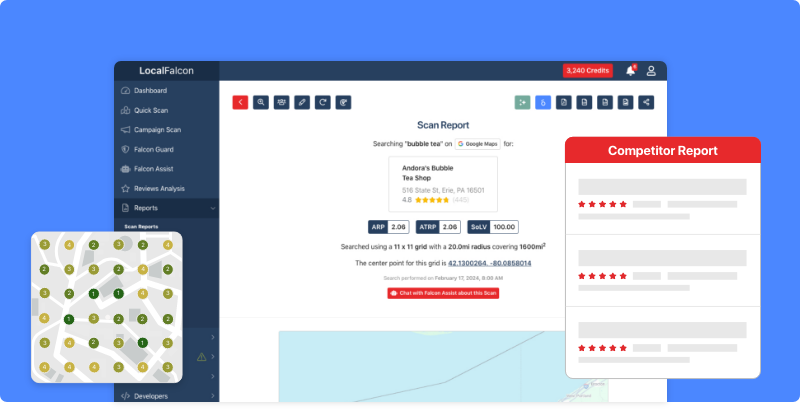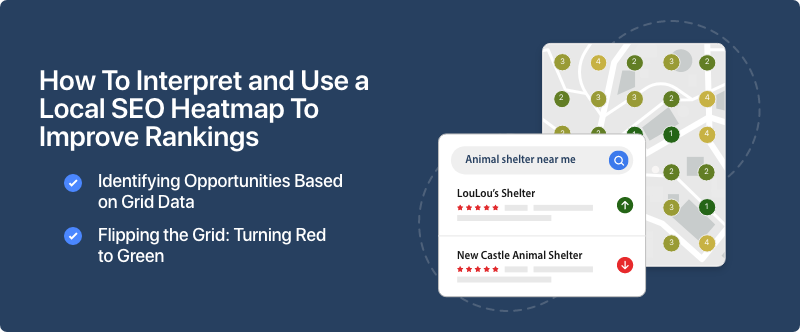Ranking well in local search is crucial for attracting customers, but businesses often struggle to see exactly where they are most visible and where they're missing opportunities. A local search grid, also known as a local SEO heatmap, solves this by providing a precise, visual representation of search rankings across multiple locations.
Instead of solely providing a single-location ranking, such as an average position across an entire zip code, a local search grid helps businesses see the bigger picture, allowing them to identify precisely where they're appearing in local search results and where they're struggling to achieve any kind of local search visibility at all.

What Is a Local Search Grid?
A local search grid is a visual representation of a business's rankings in local search results across a defined geographic area. This type of local SEO grid provides a multi-point analysis that reveals how rankings vary at the hyperlocal level across a larger region. Depending on the tool you use, the rankings can be from different sources, including Google Business Profile, Apple Maps, or even AI visibility platforms.
The search grid consists of multiple data points, which are laid out in an evenly spaced grid pattern over a map. Each of these points represents a location where a simulated local search is performed. The results of these searches are then displayed using a numbered and color-coded system, allowing businesses to instantly see where they rank well and where improvements are needed.
By default, local search grids follow set sizes like 5x5, 7x7, or 9x9, corresponding to 25, 49, or 81 data points, respectively. These grids are designed to cover a specific radius, measured in miles or kilometers, which determines how far from the business location rankings are analyzed. This makes it easy to evaluate ranking performance at a glance across a business's target market.
Customizing a Local Search Grid for Accuracy
Because different geographic regions have unique characteristics, local search grids can sometimes be customized for more precise analysis.
For example, if a business is near a large body of water, a mountain range, or an unpopulated area like a national park, the standard grid may include data points where customers are unlikely to be searching.
These irrelevant points can skew overall ranking interpretations, making a business's visibility look worse than it actually is. To prevent this, businesses can remove data points over uninhabited areas and focus only on locations where real customers are searching.
Grid size and spacing can also be adjusted based on local market conditions. In dense urban environments where competition is high, businesses may need a more granular grid with tightly spaced data points over a smaller area.
On the other hand, businesses in suburban or rural areas may benefit from a wider search radius, ensuring rankings are tracked across a broader area where customers may be traveling from.
Why Is It Called a Local SEO Heatmap?
The term local SEO heatmap comes from the way these grids visually represent rankings using a color-coded system.
A heatmap for local SEO visually highlights where a business is ranking well and where improvements are needed. This system makes it easy to identify strong and weak areas at a glance.
Dark green markers indicate that a business is ranking highly in the local pack, typically in the top three positions. These are the areas where the business has the most visibility and is most likely to attract customers.
For most businesses, the center point of the heatmap, which is the business's address, will show a dark green marker, indicating that it is showing up in the top three positions when people search from the business's location.
Light green or yellow-green points represent locations where the business has decent rankings but has not yet reached the top positions. In these areas, minor SEO adjustments can often lead to significant ranking improvements.
As rankings decline, the colors shift toward yellow, orange, and red. Yellow and orange areas indicate that the business ranks lower in the local pack, meaning potential customers may need to scroll further to find it. Red zones represent locations where the business is virtually invisible in search results, highlighting areas where consistent SEO efforts are needed to gain visibility.
How To Interpret and Use a Local SEO Heatmap To Improve Rankings
A local SEO grid is much more than a static ranking report. It's a strategic tool that businesses can use to track progress, analyze competition, and optimize their local SEO strategy over time.

Identifying Opportunities Based on Grid Data
One of the biggest advantages of using a heatmap for local SEO is that it helps businesses identify ranking opportunities with precision. If a business sees that it ranks well in some areas but not in others, it can adjust its strategy to improve performance in weaker zones.
For example, if a business notices that it has light green or yellow-green rankings in certain areas, this suggests that it is already visible but could break into the top three with minor optimizations. These are prime opportunities for quick SEO wins, where small adjustments, such as updating key Google Business Profile information, acquiring local backlinks, or increasing customer engagement, can push rankings higher.
In contrast, yellow, orange, and red zones indicate areas where visibility is weak or nonexistent. To improve rankings in these locations, businesses need to take a more aggressive, continuous approach. This might involve strengthening local content, creating local landing pages, earning more positive customer reviews, and expanding local citations and backlinks to build authority in those specific regions.
Additionally, tracking competitor rankings and comparing your heatmap to that of your top competitors' can reveal areas where they are outperforming you, helping you adjust your strategy to close the gap. This type of competitor analysis can be pivotal in helping small and medium-sized businesses compete with larger ones online.
Flipping the Grid: Turning Red to Green
The goal of using a local search grid is to gradually turn red areas into green over time. The best way to approach this is by starting from the center of the grid, which typically represents the business's physical location and their highest ranking, and working outward.
Since Google tends to rank businesses higher in searches conducted near their location, most businesses will already have strong rankings in the immediate area. The challenge is expanding this visibility outward, ensuring they appear in the local pack even in neighborhoods and districts farther from their primary location.
By consistently optimizing their Google Business Profile, earning more reviews from customers in target areas, and creating locally relevant content, businesses can expand their search presence in a systematic way. Over time, they should see their heatmap transform from a mix of red, orange, and yellow to more green, reflecting better visibility across their entire service area.
Where Can You Get a Local Search Grid or Heatmap for Local SEO?
For businesses and SEO professionals looking to track and improve local search performance, Local Falcon offers one of the most comprehensive and accurate geo-grid rank tracking tools available.
As the original creator of the local SEO heatmap format, Local Falcon provides advanced tracking and analysis capabilities that help businesses refine their strategies and achieve better rankings.
With Local Falcon, users can:
- Analyze Google local pack rankings at multiple points across their service area.
- Compare rankings against competitors to identify strengths and weaknesses.
- Monitor ranking improvements over time with historical data tracking.
- Customize grid size and placement for the most accurate insights.
With Local Falcon's local search grid, businesses can make more data-driven decisions to improve their visibility, attract more customers, and outperform competitors in local search.
For agencies working with local businesses, Local Falcon's geo-grid rank tracking helps demonstrate the value of local SEO services by providing easy-to-interpret data that clients can use to understand their ROI.
Wrapping Up
A local search grid or local SEO heatmap is an invaluable tool for understanding how a business ranks in local search results across a geographic area.
Unlike traditional ranking reports, which provide limited insights from a single location, a search grid offers a comprehensive view of search performance across multiple points.
By analyzing ranking patterns and color-coded data points, businesses can identify opportunities for improvement, refine their SEO strategies, and expand their local search dominance.
Local Falcon's geo-grid rank tracking makes it easy to monitor rankings, adjust strategies, and achieve higher visibility in Google's local pack.
If you want to take control of your local SEO and outshine competitors, a local search grid is an essential tool. Start tracking your rankings today with Local Falcon and turn insights into action!


